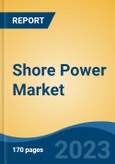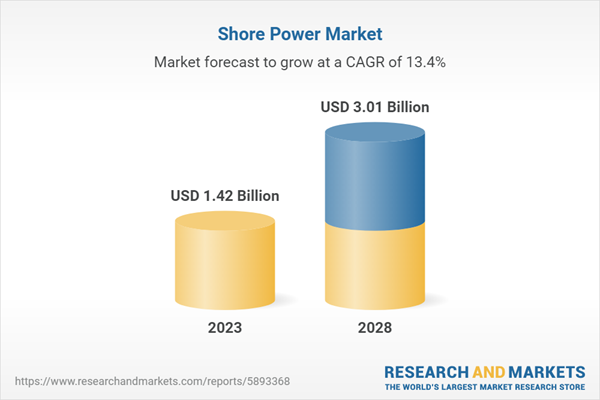Free Webex Call
The Global shore power market is expected to grow at a robust pace during the forecast period, 2024-2028 due to the government's favorable rules and regulations for reducing greenhouse gas emissions, low-frequency noise, and emissions at ports. Additionally, the rise of cruise liners in the maritime sector is projected to offer market participants a chance to expand. Speak directly to the analyst to clarify any post sales queries you may have.
10% Free customizationThis report comes with 10% free customization, enabling you to add data that meets your specific business needs.
Shore power is the process of offering electrical power from the shore to a vessel at dock, thereby admitting the supporting engines to be turned off. By plugging in and shutting off these engines, shore power effectively reduces diesel emissions and other air pollutants that would otherwise come from continuing the vessel’s on-board supporting engines.
Increasing Demand for Decrease in Low-Frequency Noise and Emissions at Ports
Ships that are parked or dry-docked can use marine power to use shore power to run essential equipment like lighting, ventilation, cargo pumps, communications, and other on-board electrical systems while turning down auxiliary engines. It enables the crew to preserve the vessel's diesel engine while breathing and reduces low-frequency noise and vibration. Companies that ship goods must cut expenses and emissions. Additionally, it is a short-term solution that is quicker and less expensive that enables shipping businesses to fulfil emissions requirements. As a result, the market is anticipated to be driven by the power supply's positive qualities described above. The risk of ships hitting whales and underwater noise are two further environmental effects of shipping that are impacted by speed optimization and decrease.Significant attempts have been made to develop underwater noise measurement standards, particularly ISO 17208, to establish a uniform metric for underwater noise emitted by merchant ships. During sea trials, all relevant factors were considered, including site selection, environmental factors, measurement device requirements, test protocols, and analysis and interpretation of measurement data. The Classification Society regulations include additional requirements, and ISO standards are now being created expressly for shallow water sea trial surveys. Currently, unique sea tests are used to determine whether it satisfies the requirements of classification societies for underwater noise. The evaluation of noise reduction strategies during the underwater design phase is aided by analytical techniques and tools for forecasting radiated noise underwater. Consequently, shore power systems assist marine enterprises in reducing noise and achieving emissions goals.
The above factors are expected to boost the global shore power market.
Favorable Government Rules and Regulations for Lowering Greenhouse Gases Emission is driving the growth of Global Shore Power Market
Shore power helps in lowering greenhouse gases emission, emitted by supporting diesel engines while docked. Therefore, governments are concentrating on funding this technology on a worldwide scale as a result. For instance, the European Commission has mandated that all European ports have a shore connection system. In addition, the Environmental Ship Index developed by the World Ports Climate Initiative rates ships according to the quantity of nitrogen oxides, Sulphur oxides, and carbon dioxide they produce. The greener the ship, the lesser the fees, as ports are increasingly utilizing ESI to determine port fees.Shore power would become a more attractive alternative as fuel prices rise and the need that ships to utilize low-sulfur, high-grade marine fuels become a global standard. The potential to put shore power on ships has gained new momentum as a result of a motion made by the European Parliament to demand a restriction on greenhouse gas emissions from berthing ships. Despite the fact that cold ironing technology is advanced, market expansion is facilitated by EU initiatives and general efforts to enhance the environment near important ports. As a result, the market expansion during the projection period is likely to be driven by this favorable government policy to reduce greenhouse gas emissions.
High Installation and Maintenance Costs are Expected to Hinder the Growth of Global Shore Power Market
On-board frequency conversion and the cost of supplying the jetty with high-voltage electricity are major factors responsible for the high installation cost of this technology. Additionally, the weight of this equipment makes transportation challenging, reduces overall flexibility, and raises maintenance expenses. Higher installation and maintenance expenses as a result limit market expansion.During the forecast period, the global pandemic and the coronavirus outbreak have become major obstacles and market uncertainties in the maritime shipping industry. This would have a negative impact on the transportation sector. As a result, the COVID-19 situation has hampered maritime shipping, which would have an impact on the market for several years.
Shore power systems have fixed investment expenditures as well as ongoing operating expenses. Shoreside and shipside fixed investments include the installation of high-voltage power, transformers, switchboards, control panels, cable reel systems, electrical distribution systems, and frequency converters. Frequency converter equipment and quayside high-voltage power supply make up the two major costs connected with shoreside infrastructure, together making up nearly half of the overall fixed expenditure. Depending on the kind and size of the vessel as well as if an on-board transformer is required, the cost of shipside modifications might range from USD 0.3 million to USD 2 million. Retrofit and new-build projects differ significantly from one another in terms of cost, with retrofits frequently costing up to twice as much as incremental new-build investments. The main operational costs are taxes and the cost of power, both of which are localized. Although some electricity suppliers levy connection fees, several nations, including Sweden, lower taxes on electricity consumed by shore power systems.
Thus, the above factors are expected to cause hindrance to the growth of global shore power market.
Market Segmentation
The global shore power market is segmented based on installation, power output, connection, component, and region. Based on installation, the market is bifurcated into shoreside, shipside, and others. Based on power output, the market is bifurcated into up to 30 MVA and above 30 MVA. Based on connection, the market is bifurcated into new and retrofit. Based on component, the market is bifurcated into transformers, switchgear, converters, cables, and others. Based on region, the market is further bifurcated into North America, Asia-Pacific, Europe, South America, and Middle East & Africa.Market players
The main market players in the Global Shore Power Market are ABB Ltd., Siemens AG, Schneider Electric SE, Cavotec SA, Wartsila Corp, Vinci Energies S.A., Danfoss A/S, ESL Power Systems, Inc. (ESL), Blueday Technology AS, and Cochran Inc.Report Scope:
In this report, global shore power market has been segmented into the following categories, in addition to the industry trends which have also been detailed below:Shore Power Market, By Installation:
- Shoreside
- Shipside
- Others
Shore Power Market, By Power Output:
- Up to 30 MVA
- Above 30 MVA
Shore Power Market, By Connection:
- New Installation
- Retrofit
Shore Power Market, By Component:
- Transformers
- Switchgear
- Converters
- Cables
- Others
Shore Power Market, By Region:
- North America
- United States
- Canada
- Mexico
- Asia-Pacific
- India
- Japan
- South Korea
- Australia
- China
- Europe
- Germany
- United Kingdom
- France
- Italy
- Spain
- South America
- Brazil
- Argentina
- Colombia
- Middle East
- Saudi Arabia
- South Africa
- UAE
Competitive Landscape
Company Profiles: Detailed analysis of the major companies present in the global shore power market.Available Customizations:
Global shore power market report with the given market data, the publisher offers customizations according to a company's specific needs.This product will be delivered within 1-3 business days.
Table of Contents
1. Product Overview
2. Research Methodology
5. Global Shore Power Market
6. North America Shore Power Market Outlook
7. Asia-Pacific Shore Power Market Outlook
8. Europe Shore Power Market Outlook
9. South America Shore Power Market Outlook
10. Middle East & Africa Shore Power Market Outlook
11. Market Dynamics
13. Company Profiles
15. About the Publisher & Disclaimer
Companies Mentioned
- ABB Ltd.
- Siemens AG
- Schneider Electric SE
- Cavotec SA
- Wartsila Corp
- Vinci Energies S.A.
- Danfoss A/S
- ESL Power Systems, Inc. (ESL)
- Blueday Technology AS
- Cochran Inc.
Table Information
| Report Attribute | Details |
|---|---|
| No. of Pages | 170 |
| Published | October 2023 |
| Forecast Period | 2023 - 2028 |
| Estimated Market Value ( USD | $ 1.42 Billion |
| Forecasted Market Value ( USD | $ 3.01 Billion |
| Compound Annual Growth Rate | 13.3% |
| Regions Covered | Global |
| No. of Companies Mentioned | 10 |









